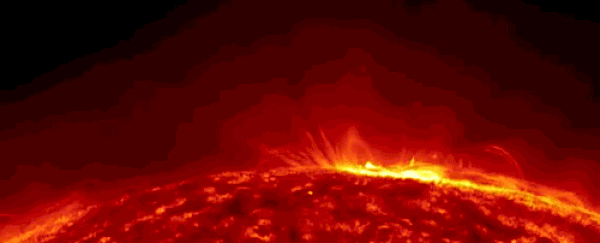Researchers have found evidence that the same giant, magnetised waves that ripple through Earth's atmosphere might also exist on our Sun.
These waves are known as Rossby or planetary waves, and they usually occur way above Earth's surface, influencing weather patterns and the jet stream winds. But this is the first time the waves have been spotted on the Sun - and in this case, they're planet-sized.
The discovery could explain why solar activity such as solar storms and flares are so hard for us to predict - something that could become an issue in future if a powerful solar flare is directed straight at Earth.
"The discovery of magnetised Rossby waves on the Sun offers the tantalising possibility that we can predict space weather much further in advance," said lead researcher Scott McIntosh, from the US National Centre of Atmospheric Research.
On Earth, Rossby waves occur both in the atmosphere and in the oceans, and they form in rotating fluids. In the atmosphere, these waves affect the path of the jet stream winds and the formation of low- and high-pressure systems, which affect the weather we experience on the ground.
In the ocean, a huge Rossby wave have been spotted travelling westward around the planet, and is responsible for a strange humming sound coming from the Caribbean sea.
Considering that the Sun is rotating, and is largely made up of plasma that acts like a vast, magnetised ocean, it was suspected that Rossby-type waves might also form on our host star. But this is the first time researchers have ever been able to detect them.
In the past, attempts to spot these waves had failed, because we've only had one vantage point from which to study the Sun: here on Earth.
But there was a brief window between 2011 and 2014 during which researchers saw the Sun's entire atmosphere at once, thanks to observations from NASA's Solar Dynamics Observatory and Solar Terrestrial Relations Observatory - the latter mission was made up of two separate spacecraft sent into orbit around the Sun.
That data allowed McIntosh and his team get a 360 degree view of the Sun and see if any Rossby-like patterns emerged.
They found bands of magnetised activity that propagated slowly across the Sun - very similar to the Rossby waves found here on Earth.
These waves appear to move westward, on average, at a speed of about 3.25 metres (10.7 feet) per second in the Sun's northern hemisphere, and about 2.65 metres (8.7 feet) per second in the southern hemisphere
It's still early days, and at this stage, the team is unsure what impact these waves are having on the Sun. But one hypothesis they're investigating is that the waves could be linked to the Sun's 11-year solar cycle, where solar activity regularly peaks and drops off.
"It's possible that it's all tied together, but we needed to have a global perspective to see that," said McIntosh.
"We believe that people have been observing the impacts of these Rossby-like waves for decades, but haven't been able to put the whole picture together."
If solar activity is linked to these Rossby-like waves, it would be a huge deal for our understanding of the Sun's unpredictable weather patterns - solar flares are known to mess with telecommunications here on Earth, but we still struggle to predict when they're coming.
"Bad weather in space can hinder or damage satellite operations, and communication and navigation systems, as well as cause power-grid outages leading to tremendous socioeconomic losses," said Ilia Roussev from the US National Science Foundation, which supported the work.
"Estimates put the cost of space weather hazards at US$10 billion per year."
The bad news is, until researchers get another 360-degree glimpse of the Sun, it's going to be a struggle to map out what all of this means. Let's hope this is incentive for NASA to get some more eyes on our Sun - sooner rather than later.
The research has been published in Nature Astronomy.
